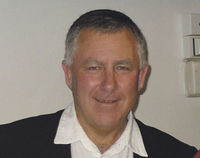Archbishop John Dew
November 2011
 In October [2011], I invited you to a book launch. The New bi-lingual Missal for New Zealand will be launched and used for the first time in parishes on the first Sunday of Advent, November 27.
In October [2011], I invited you to a book launch. The New bi-lingual Missal for New Zealand will be launched and used for the first time in parishes on the first Sunday of Advent, November 27.
Over the past two years, parishes and chaplaincies have been using the interactive DVD, Become one Body, one Spirit in Christ, to deepen their understanding and appreciation of the Mass, as the centre and heart of Catholic worship. If you have not yet seen this DVD I suggest that some viewings and discussion be arranged in liturgy committees, your parishes/pastoral areas. It is a wonderful resource on the Eucharist. Through the homily series last year, we were invited to rediscover the examples in the liturgy of the presence of Christ:
• in the gathered assembly,
• in the proclamation of the Word of God,
• under the forms of Bread and Wine in the Eucharist, and
• in the person and ministry of the priest.
We know that the Eucharist both calls us in, and sends us forth to continue to be that presence of Christ to others, to discover again at depth the presence of Christ in all those we meet in daily life and to take Christ with us. We are sent out with the words ‘Go and announce the Gospel of the Lord’.
One of the sections of the DVD is entitled: ‘Rediscovering the Art of Liturgy’: Liturgy is supposed to be something beautiful, sometimes simple, sometimes very grand, but always beautiful. Liturgy is an act of the whole church that reaches out beyond the immediate community assembled in a particular time and place; it reaches out to all those we meet. That is why this particular ‘book launch’ is so important; it is about our lives and the effect our lives as Catholics have on the world around us.
When he is ordained, the priest who presides over the Eucharist, hears these words: ‘Know what you are doing and imitate the mystery you celebrate’. As the priest lives among the people, he is called to relate to them as Jesus, he is to develop relationships and be their pastor day to day, week by week.
But the priest is not alone in celebrating the Mass. Many people bring their gifts through such ministries as hospitality, music, and as proclaimers of the Word and ministers of Holy Communion who extend the Eucharist of the local community to the sick and house-bound. All are called to be caught up in the ‘Mystery of Christ’ celebrated in the Mass and to experience the redeeming presence of Christ.
Beautiful liturgical objects, such floral art and banners that highlight the scriptural theme of the day or season, as well as movement, speech, music and silence fully engage each one of us and invite us to a full participation in the worship of God. That is why the archdiocese is committed to helping people discover the gifts they have, to value these gifts, and to place them at the service of the community.
Catholic liturgy is also described as a ‘received liturgy’. This is because we are linked to the early Christian community and, before that, to elements of Jewish worship and blessings. There is a rhythm of word, listening and action that unite us with Christians throughout history. When liturgy is received as gift, it teaches and forms us into the depths of the Christian life, of participation in the life, ministry, death and resurrection of Jesus Christ. It is received, but we are not passive observers. We each have a part to play, a gift to bring. As Pope Benedict wrote in Deus Caritas Est ‘A Eucharist which does not pass over into the concrete practice of love is intrinsically fragmented’ (DCE 14).
The liturgy links us across time and culture and, over the centuries, to the church in different eras and circumstances.
Many of us who have worked or travelled overseas have been deeply moved by the celebration of the Mass in other languages and rites, in a contemplative Mass in Asia, a vibrant celebration in Latin America or East Africa, a Mass sung in Gregorian chant in a monastic community, Mass accompanied by joyful Polynesian dance and singing, or perhaps even the ‘gathering of two or three’ in countries where Catholics are a very small minority.
The Church encourages this adaptation or inculturation of the liturgy, according to the language and culture of peoples.
This liturgical inculturation is happening in New Zealand too. A unique feature of the new missal is that for the first time we have a formal bi-lingual missal in English and Maori. This has been in preparation for many years, in collaboration with Fr Trevor Murray of the National Liturgy Office and a national translation team. In June Fr Murray went with Fr Henare Tate to Rome to support the texts and to receive approval for the Maori texts.
The First Sunday of Advent when the new missal is introduced will be an historic day for the Church in New Zealand. Please remember that these are more than just words and particular translations. They are words which help us to celebrate the mysteries of God.